
The endless series continues!
In this post, I’ll cover the design principles I used (or at least tried to use) as I planned our landscaping. As I’ve said in the previous posts, this project was greatly inspired by the wonderful book, Planting in a Post-Wild World.
Planting shakes up our basic assumptions about what a landscape is, and how it functions. I tried to absorb this information as best I could, and used it to inform my design. Here’s a quick summary of the five basic design principles the authors lay out:
Principle 1: Related populations, not isolated individuals
Don’t think of plants as individual specimens to be arranged, as you’d arrange your furniture in the living room. Instead, conceive of the area as an interrelated community. The design process is more akin to putting together a puzzle than arranging a room. How do these plants relate, how to do they fit together, how do they function together?
Principle 2: Stress as an asset
When we start a garden, we want level everything out, turn over the soil, add lots of water and amendments because we think that is what gardening is all about. This makes for boring gardens, and for weak gardens. Gardens are given character, given a strong sense of place, by their limitations: a dry garden, a beach garden, a rock garden, a wetland. Don’t fight the site, embrace it. Let the plants work it out themselves.
Principle 3: Cover the ground densely by vertically layering plants
Bare soil is uncommon in nature, being found only in deserts and a few other extreme environments. Plants want to live cheek by jowl (to use a very poor metaphor!) with other plants. They are cooperative by nature. Yet our yards have vast areas of bare soil–under trees, around bushes, for instance–and you’ll note we spend a lot of time and energy trying to keep those areas “clean”. Weeds naturally rush in to fill those gaps, because nature abhors bare soil. Rainer and West advocate “green mulch” — covering all the soil with plants. (Wood chip mulch is better than bare soil, but not as dynamic as green mulch). There is an art to planting many species close together, and that is what the book is about, in essence.
Principle 4: Make it attractive and legible
I’ve already talked about legibility some in my last post. We are saddled with some kind of devolved 18th century British concept of the picturesque as the model for our landscaping, no matter where we live, no matter how unrealistic that might be. Thus the continuing ascendancy of the lawn and the specimen tree as the be all and end all of suburban landscaping.
It is difficult to challenge this model with more naturalistic landscaping. If a design is not going to cause complaints and wrinkled noses, it can’t look “too wild.” This means using hardscaping strategically to make a landscape look well planned, and to also mix in more traditional landscape elements with wilder ones. A good strategy, for instance, is to keep some mowed turf as a border or frame for a wild area. The contrast between the manicured turf and the more loose and rangy plant forms can be really appealing, and the turf demonstrates that the garden is in fact a tended space.
Principle 5: Management, not maintenance
If a yard is designed as a functioning plant community, not as a collection of specimens, you should not have to spend much time attending to the plants as individuals. Instead, you oversee the community. This is not a “no work” landscape–it’s a different type of work. Mowing and blowing and watering and fertilizing are replaced with observation and measured response when necessary. Your yard becomes a complex, adaptive system and you have develop the humility to let that roll to some extent.
Three landscape archetypes
Again, this is only the most basic overview of some pretty complex ideas. You gotta read the book! But it should give you some sense of what I was thinking about as I entered my design process.
To illustrate these five principles listed above in more concrete ways, Rainer and West focus on the examples of three landscape archetypes:
1.The grassland, a.k.a.the meadow, the lawn substitute.
2.Woodland/shrublands, which is a mixed landscape of grasses, shrubbery and trees, which is to say, the elements of the classic suburban yard.
3. The forest, which is design in cooperation with stands of trees.
They take apart each archetype in detail and discuss the design considerations for each, the possibilities and potential problems. I focused on the grassland section, because I had already decided that I wanted my slope covered with low growing, meadow-type plants.
As I’ve already discussed, we were not willing to rebuild the slope, to change the retaining walls or drag up huge boulders or install a waterfall or do anything dramatic to alter the site. It is what it is: three terraces boxed in between the garage and the stairs. As a result, the process was fairly straightforward–the entire project was about choosing the right plants for the existing site.
A sideline: natives vs. exotic
This is a hot button issue in the gardening world. Rainer and West have a very nice stance on native vs. exotic plants. They are not native purists. They point out that in a disturbed environment like an urban center, where even the soil might be imported, it doesn’t make a lot of sense to chase after a lost past, especially when local conditions have changed so much that what once might have grown there simply can’t anymore. It’s more important to focus on what works, and on fostering abundant life.
But they do like the way native plants give a strong sense of place and local identity. They also point out that in terms of the color palette and general aesthetic feel of the species, natives tend to go together well.
If you have a selection of native species, and you bring in a non-native to fill a specific function in the community you’re designing, that’s fine, and it might work out well, but you also have to be careful and make sure that non-native blends well visually with the natives. For instance, here in Southern California our native greens are not a very rich green, they tend toward silver. If I bring in plant from somewhere else, and it is a rich green, it might really stick out.
And of course, it’s easier to put together a functioning plant community with native plants because you know, theoretically, that the plants should work together, whereas if you’re working with a mix of plants from different places, you need to really study up on their habit and function to make the right decisions about how to use them.
I love our California native plants, but I’m not a purist, either. Yet I did end up using only natives for this project, for a few reasons. First and foremost, I know my native plants better than I know the exotics, just from the experience of using them in my yard over the years. It’s a smaller set of variables and information to juggle.
The difficult thing about Southern California’s mild climate is that if you’re willing waste the water, you can plant just about any plant from anywhere in the world in your yard and it will probably live. (This is, by the way, why we have such a crazy urban landscape, with one house growing Hawaiian tropicals next to another house with a desert landscape next to another house with Midwestern conifers and a lawn. )
Save me from too much choice! Also, with our climate heating up and ongoing drought a possibility, I want plants that are not just “drought tolerant”, but which have specifically evolved to live months on end with no moisture. But even if I limit my selections to plants from Mediterranean climates, I have no desire to study up on the flora of Australia, South Africa, Greece, Italy and Chile. So I’m happy to stay within the limited palette of California natives.
And of course, I wanted to encourage what’s left of our wildlife, our native insects particularly, by planting food sources for them.
Designing a community
Rainer and West emphasize that a community is built in layers. They want close planting. They point out that a natural meadow, or even a vacant lot colonized by weeds, will host hundreds of species on one patch of ground. Compare this to the paltry biodiversity of our typical yard, where the number of species can often be counted on one hand. To get this kind of diversity, plants need to be layered densely, so every possible niche is filled.
They point out that a design might look closely planted from above, but if you get down on your knees and look at the soil at ground level, there may be all sorts of bare soil between the plants. To avoid this, you plant in layers, from the ground up. They identify four types of functions for plants in your design:
Ground cover plants: They emphasize the importance of ground cover plants as the base layer of the community. These are low, somewhat nondescript, spreading, shade tolerant plants which don’t mind living under the taller, flashier plants. They hold the soil, hold water and discourage weeds.
Seasonal theme plants: These are mid-height plants which have a lot of seasonal interest. They provide color when they bloom. When not in bloom, they should still function well within the community. Ideally there are a number of species to provide continual bloom and color throughout the year.
Structural/framework plants: These are the biggest, showiest plants, and also the ones that persist no matter what the season, making them the bones of the garden. This includes trees and bushes, as well as large perennials. In a grassland landscape where there are no trees or bushes, this category would include tall grasses as well as plants with dramatic seed heads which persist long after the bloom.
Filler plants: These are the transitory, often self-seeding plants which pop up opportunistically to fill empty spaces. Wild flowers are a good example. They will fill open space in the garden in the early spring, while the perennials are getting up to speed. By the time the perennials shade them out, the wildflowers are pretty much done anyway.
How I started:
I started by considering the site, the light and the soil conditions. I considered native plants I knew already, and got some books out of the library and began reading. I also used Internet resources, particularly the Theodore Payne wiki, for looking up native plant specs.
I realized that in the past, I had always thought of native plants (all plants, really) as specimens. I’d say to myself, “I really want a white sage.” And then I’d get one and find somewhere to plant it. I never thought about the whole yard as a system.
This process is very different. I had to think about function first. I thought in terms of category. For instance, I needed ground cover. Which native plants would function that way in my yard? I learned to stop thinking about plans as specimens.
I made lists. Lots and lots of lists. I incurred library fines by holding onto favorite resources too long.
Complicating all of this is the fact that the space I’m working on is quite small. I needed smallish, well behaved plants to make something which looked like a meadow. Also, as I discussed before, I didn’t want anything too tall. I wanted a clear view up the slope. Really tall grasses and flowers are part of meadow communities, but not this one. In mine, I wanted everything about knee high or less, with the exception of flower stalks. Sometimes I felt like I was building a model train or something similarly miniature and persnickety.
Design tools
Diagrams of the space were really helpful. Erik rendered the slope in SketchUp (a free 3D modeling program) as a part of a project to eventurally render our entire property. SketchUp renderings are really useful, particularly when you’re designing hardscape additions, like decks, for instance. You can design the new element, drop it into your existing set-up, and spin it around and see what it looks like from all angles.
I’ll have to say, though, that I did not find it very helpful for working out planting arrangements. What I ended up doing instead was drawing a scale drawing of the slope from a bird’s eye perspective on a big sheet of paper, with grid lines to show square feet. Then I put tracing paper over the drawing, and could sketch in design ideas, using rough shapes and circles to represent plants. The grid lines helped a lot with figuring out how many plants could fit in a given area. I went through a lot of tracing paper. I used it for everything from the quickest sketches and notes (“tall stuff here”) to the final, detailed planting diagram.
The problem of time
Design with plants is one of the most challenging forms of design there is, because there are so many variables, many more than a graphic designer or an interior designer or even an architect would ever have to deal with.
Some variables aesthetic, like color, texture, leaf shape, height. Some are about the plants’ needs–light and soil and water requirements. But the most difficult, is the factor of time. No other designer has to deal with that, except filmmakers, and they only have to do it once. Gardens are time based installations which are always changing. You have to account for both plant growth and seasonal change. Some plants are longer lived than others. Some are summer or winter dormant. Plants flower and they stop flowering. They lose their leaves. Weather does strange, unpredictable things. The space is always in flux. Your design has to embrace all of that.
That is, I think, one reason why our Lawn n’ Bush landscapes prove so persistently popular. They deny time. The lawn always looks the same, ideally. The shrubbery is pretty consistent, too. In this kind of landscape there’s no surprises, no accommodation–and no life, either. I could do a long riff about our culture’s fear of death as embodied in our landscapes. We don’t want to be reminded of the wheel of life when we look out the window. All we want to see are the eternal green fields of Elysium.
But I digress.
This is enough typing for today. Next post I’ll get onto my specific plant choices and arrangements.
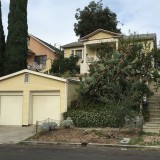
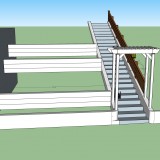

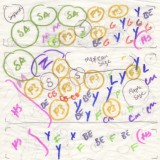
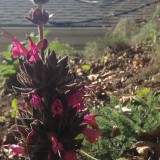
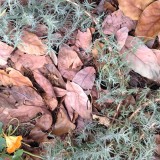
My head would explode if I put this much thought into what I planted in my yard. Maybe I can learn something after you do the -thinking. As I think about all the design elements, it makes my yard seem pitiful.
IF I had your slope, I would plant bulbs that bloom in succession over the summer. But, maybe that is not a good idea.
It’s been really fascinating to look over your shoulder as you plan all of this. It’s so complex.
Thanks for taking such a measured approach to the “natives vs exotic” issue. My neighbors have an enormous patch of invasive himalayan blackberry and, from what I can tell, the birds and various critters love it because it provides cover and berries. I can understand how it would really be awful if this invasive was crowding out a native ecosystem, but in this context, it’s encroaching over grass and other non-native weeds. It drives me crazy but it does make me feel better knowing it supports wildlife plus the neighbors in question obviously aren’t spraying pesticides everywhere.
I really need to read that book, “Planting in a Post-Wild World” now! Looking forward to your yard transformation too.